Geometric Modeling of C-Bézier Curve and Surface with Shape Parameters
Abstract
:1. Introduction
2. Basic Knowledge of C-Bézier Basis with Parameters
3. Continuity Constraints of C-Bézier Curves with N Parameters
3.1. Parametric Continuity of C-Bézier Curves with Parameters
3.2. Geometric Continuity of C-Bézier Curves
4. Examples
4.1. Algorithm for the Construction of Curves by Parametric Continuity Constraints
- I.
- For C-Bézier curve of degree n, we consider the first curve with shape parameters like and its control points .
- II.
- For continuity by keeping , we have new point and the remaining control points are left to choice.
- III.
- Similarly, for continuous, the tangent vectors of the first curve at the end point and the second curve are equal, we obtain . Therefore, the new control point of the second curve is obtained, and the remaining control points of the second curve are free to choose.
- IV.
- Finally, for continuity, the continuity condition of the two curves is first guaranteed, and the second derivative of the initial curve and the second curve is also guaranteed to be equal at the end point, that is, ; then, we get the new control point of the second curve, and the remaining control points of the second curve are free to choose.
- 1.
- continuity of cubic C-Bézier curves with parameters.Because the cubic C-Bézier curve has three shape parameters, and we can construct various figures by using the continuity of any two curves. Therefore, consider any two cubic C-Bézier curves named and containing shape parameters and , respectively:
- 2.
- continuity of cubic C-Bézier curves with parameters.We elaborate on the continuity of the curves, and, for continuity, we again consider two cubic C-Bézier curves given with three different shape parameters in Equation (14). We can also use the continuity constraints to construct various complex curves.
4.2. Algorithm for the Construction of Curves by Geometric Continuity Constraints
- I.
- For C-Bézier curve of degree n, we consider the first curve with shape parameters like and its control points.
- II.
- By keeping and equal, we obtain the control point for continuity, i.e., , and the remaining control points of the second curve will be chosen according to the designer’s choice.
- III.
- Similarly, for continuous, both the first and final curve segments with their tangent vectors will be equal at the last and first point of the domain, respectively. An extra positive scale factor will be added with the tangent vector of the second curve as to obtain for continuity. The remaining control points will be left to the designer’s choice, and a new curve will be obtained smoothly by using this condition.
- IV.
- Finally, for continuity, continuity is first guaranteed, and then control point is obtained through . Meanwhile, the remaining control points of the second curve are freely selected.
- 1.
- continuity of cubic C-Bézier curves with parameters.
- In Figure 4, control points and were selected to construct curves. In addition, is the scale factor, which has a positive value, and it is well worth modifying the shape of the curve. Through the continuity condition, and could be obtained, while the remaining control points would be taken according to our own will. All of these multiple thin and dotted curves could be attained by the variation of shape parameters. The different values of shape parameters are mentioned underneath the figures. The shape parameters in the graph appear in the form of array. The first four groups and the last four groups correspond to the curve colors in the graph: black, green, purple and red, where in the figure. Therefore, by varying the values of shape parameters, we can see the changes in the curves given in Figure 4.
- 2.
- continuity of cubic C-Bézier curves with parameters.
5. Geometric Continuity of C-Bézier Surface with Parameters
Smooth G2 Continuity for C-Bézier Surfaces with Parameters in the S Direction
6. Examples for the Construction of C-Bézier Surfaces with Parameters by G2 Continuity
- 1.
- Consider any two C-Bézier surfaces such as and .
- 2.
- Let ; both surfaces possess a common boundary and satisfy the continuity condition.
- 3.
- For any value of , and by having multiple shape control parameter values, Equation (20) can be used to calculate the second row of control mesh points to meet the continuity requirement. The remaining control mesh points can be taken according to the designer’s choice.
- 4.
- For any constant value of , the control mesh points in the third row can be calculated using Equation (23), which are the required control points for continuity. Furthermore, for the continuity condition, the previous two conditions ( continuity and continuity) must be satisfied.
7. Conclusions
Author Contributions
Funding
Institutional Review Board Statement
Informed Consent Statement
Data Availability Statement
Conflicts of Interest
References
- Yip-Hoi, M.C. Teaching Surface Modeling to CAD/CAM Technologists. Am. Soc. Eng. Educ. 2011, 22, 1403.1–1403.12. [Google Scholar]
- Schmidt, R.; Singh, K. Sketch-Based Procedural Surface Modeling and Compositing. Eurographics 2008, 27, 321–330. [Google Scholar]
- Hering, L. Closed (C2 and C3 continuous) Bézier and B-spline curves with given tangent polygons. Comput. IEEE ACM Int. Conf. Comput. Aided Des. 1983, 15, 3–6. [Google Scholar] [CrossRef]
- Yan, L. Adjustable Bézier Curves with simple Geometric Continuity Conditions. Math. Comput. Appl. 2016, 14, 44. [Google Scholar] [CrossRef] [Green Version]
- Schneide, R.; Kobbelt, L. Discrete fairing of curves and surfaces based on linear curvature distribution. Curve Surf. Des. 1999, 1999, 371–380. [Google Scholar]
- Barsky, B.A.; Derose, T.D. Geometric continuity of parametric curves: Three equivalent characterizations. IEEE Comput. Graph. Appl. 1989, 9, 60–69. [Google Scholar] [CrossRef]
- Bashir, U.; Abbas, M.; Ali, J.M. The C2 and G2 rational quadratic trigonometric Bézier curve with two shape parameters with applications. Math. Comput. Appl. 2013, 219, 10183–10197. [Google Scholar] [CrossRef]
- Qin, X.; Hu, G.; Zhang, N.; Shen, X.; Yang, Y. A novel extension to the polynomial basis functions describing Bézier curve and surfaces of degree n with the multiple shape parameters. Math. Comput. Appl. 2013, 223, 1–16. [Google Scholar] [CrossRef]
- Misro, M.Y.; Ramli, A.; Ali, J.M. Quintic Trigonometric Bézier curve with two shape parameters. Sains Malays. 2017, 46, 825–831. [Google Scholar]
- BiBi, S.; Abbas, M.; Misro, M.Y.; Hu, G. A novel approach of hybrid trigonometric Bézier curve to the modeling of symmetric revolutionary curves and symmetric rotation surfaces. IEEE Access 2019, 7, 165779–165792. [Google Scholar] [CrossRef]
- BiBi, S.; Abbas, M.; Miura, T.K.; Misro, Y.M. Geometric modelling of novel generalized hybrid trigonometric Bézier-like curve with shape parameters and its applications. Mathematics 2020, 8, 967. [Google Scholar] [CrossRef]
- Hu, G.; Bo, C.C.; Qin, X.Q. Continuity conditions for Q-Bézier curves of degree n. J. Inequal. Appl. 2017, 115, 1–14. [Google Scholar] [CrossRef] [Green Version]
- Han, X.; Ma, Y.; Huang, X. The cubic trigonometric Bézier curve with two shape parameters. Appl. Math. Lett. 2009, 22, 226–231. [Google Scholar] [CrossRef] [Green Version]
- Hu, G.; Wu, J.; Qin, X. A novel extension of the Bézier model and its applications to surface modeling. Adv. Eng. Softw. 2018, 12, 27–54. [Google Scholar] [CrossRef]
- Sharma, R. A class of QT Bézier curve with two shape parameters. Int. J. Sediment Res. 2016, 5, 131–134. [Google Scholar]
- Hu, G.; Cao, H.; Wang, X.; Qin, X. G2 Continuity conditions for generalized Bézier-like surfaces with multiple shape partameters. J. Inequal. Appl. 2017, 1, 1–17. [Google Scholar]
- Zhang, J.W. C-curves: An extension of cubic curves. Comput. Aided Geom. Des. 1996, 13, 199–217. [Google Scholar] [CrossRef]
- Zhang, J.W. Two different forms of C-B-splines. Comput. Aided Geom. Des. 1997, 14, 31–41. [Google Scholar] [CrossRef]
- Chen, Q.Y.; Wang, G.Z. A class of Bézier-like curves. Comput. Aided Geom. Des. 2003, 14, 29–39. [Google Scholar] [CrossRef]
- Li, C.Y.; Zhu, C.G. Designing developable C-Bézier surface with shape parameters. Mathematics 2020, 14, 402. [Google Scholar] [CrossRef] [Green Version]
- Wang, G.J.; Wang, G.Z.; Zheng, J.M. Computer Aided Geometric Design; China Higher Education Press: Beijing, China, 2001. [Google Scholar]
- Hu, G.; Ji, X.M.; Guo, L. The quartic generalized C-Bézier surface with multiple shape parameters and continuity condition. Mech. Ence Technol. Aerosp. Eng. 2014, 33, 1359–1363. [Google Scholar]
- Piegl, L.; Tiller, W. The NURBS Book; Springer: New York, NY, USA, 1997. [Google Scholar]
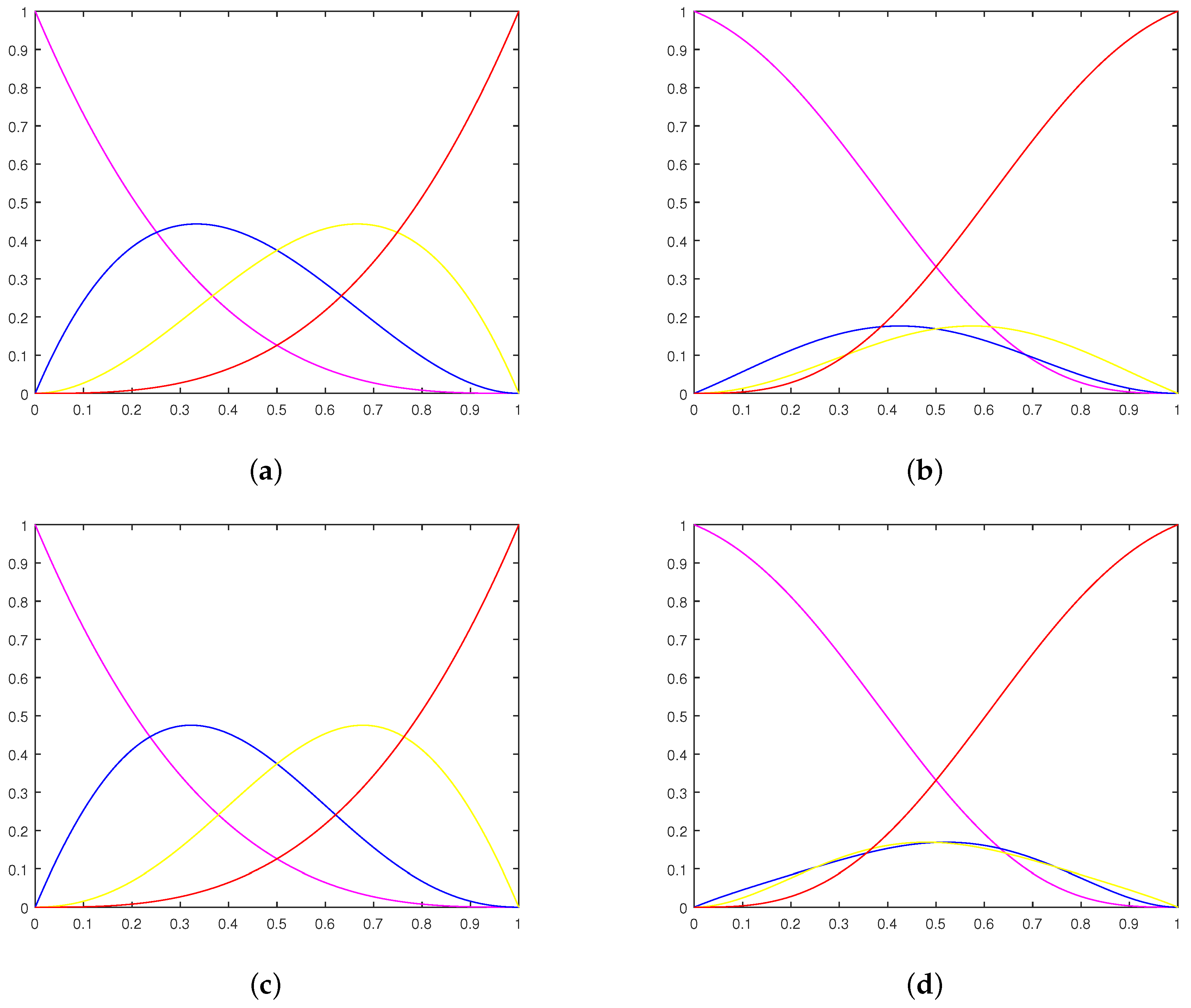


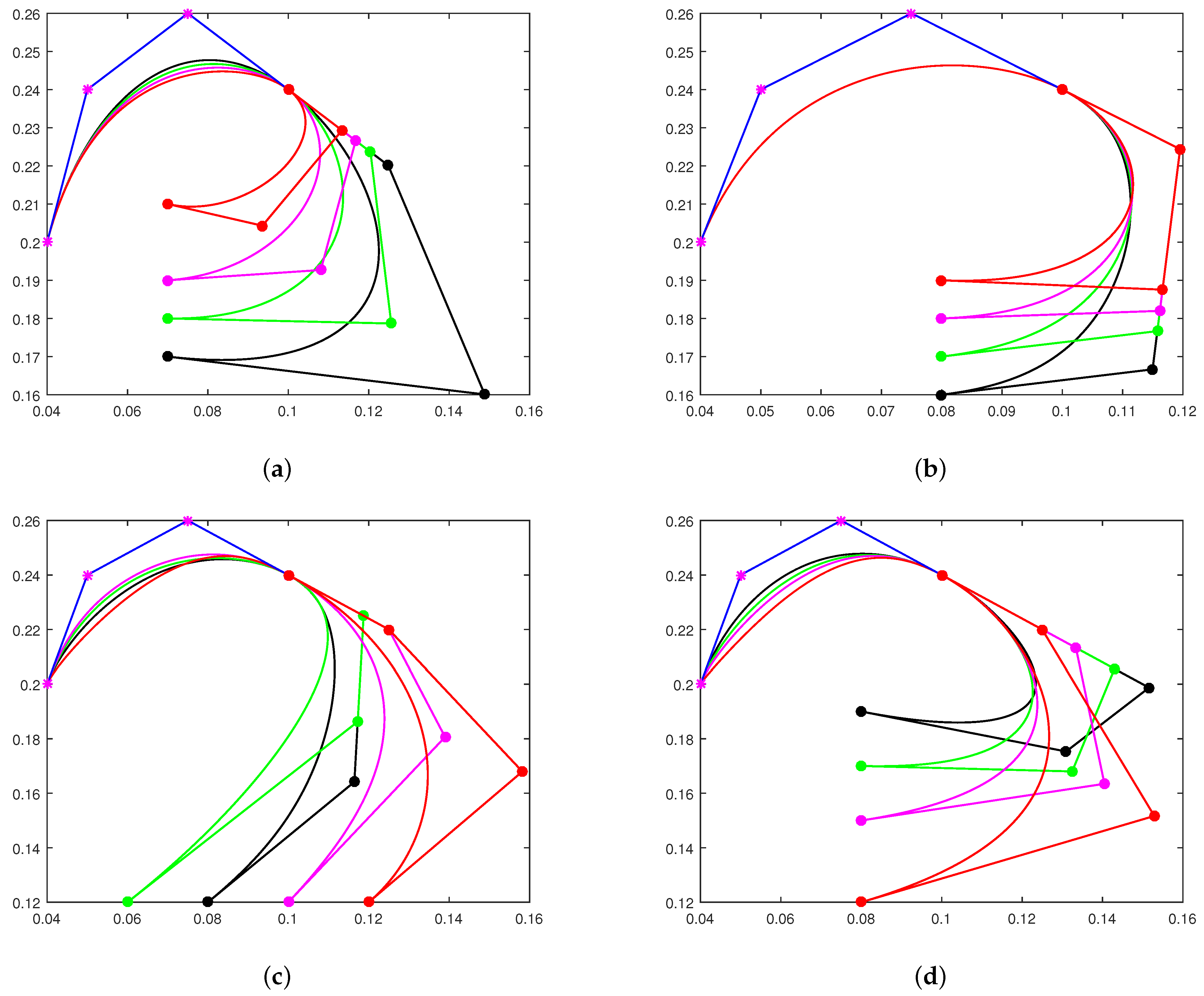
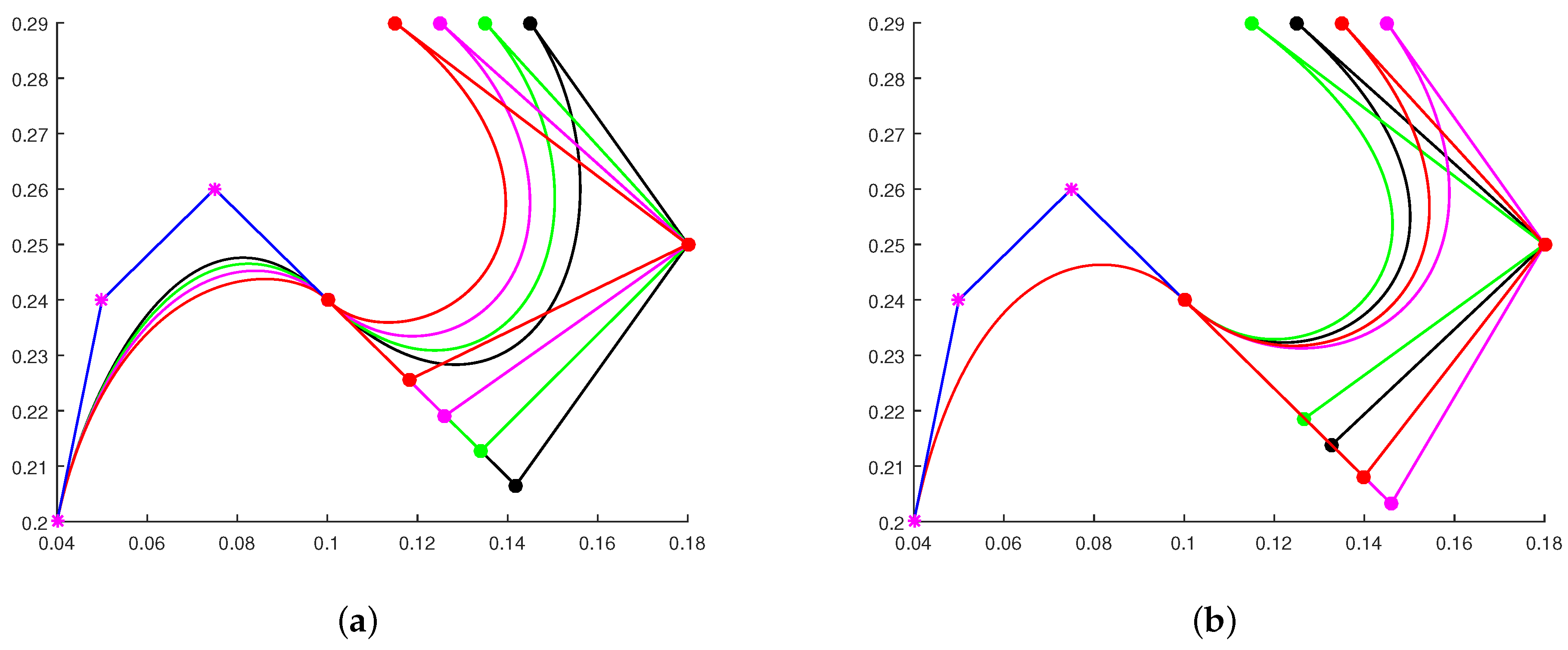
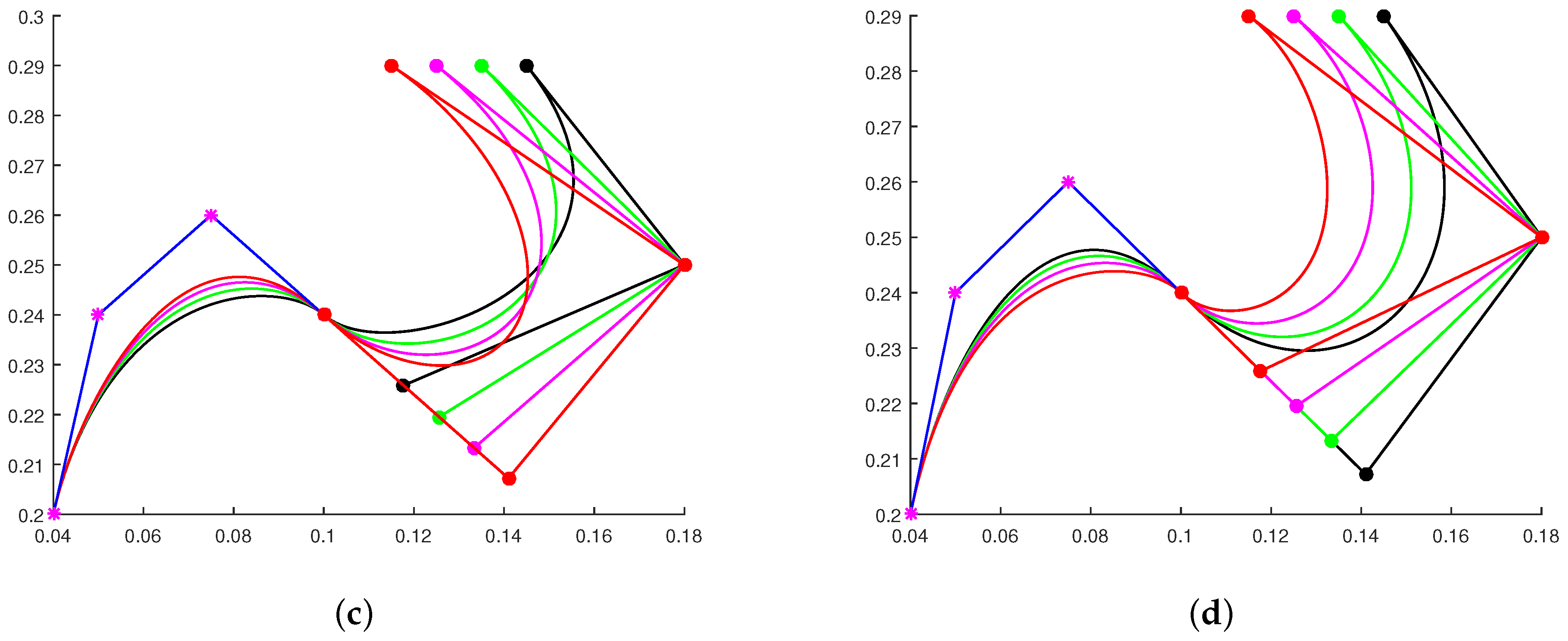
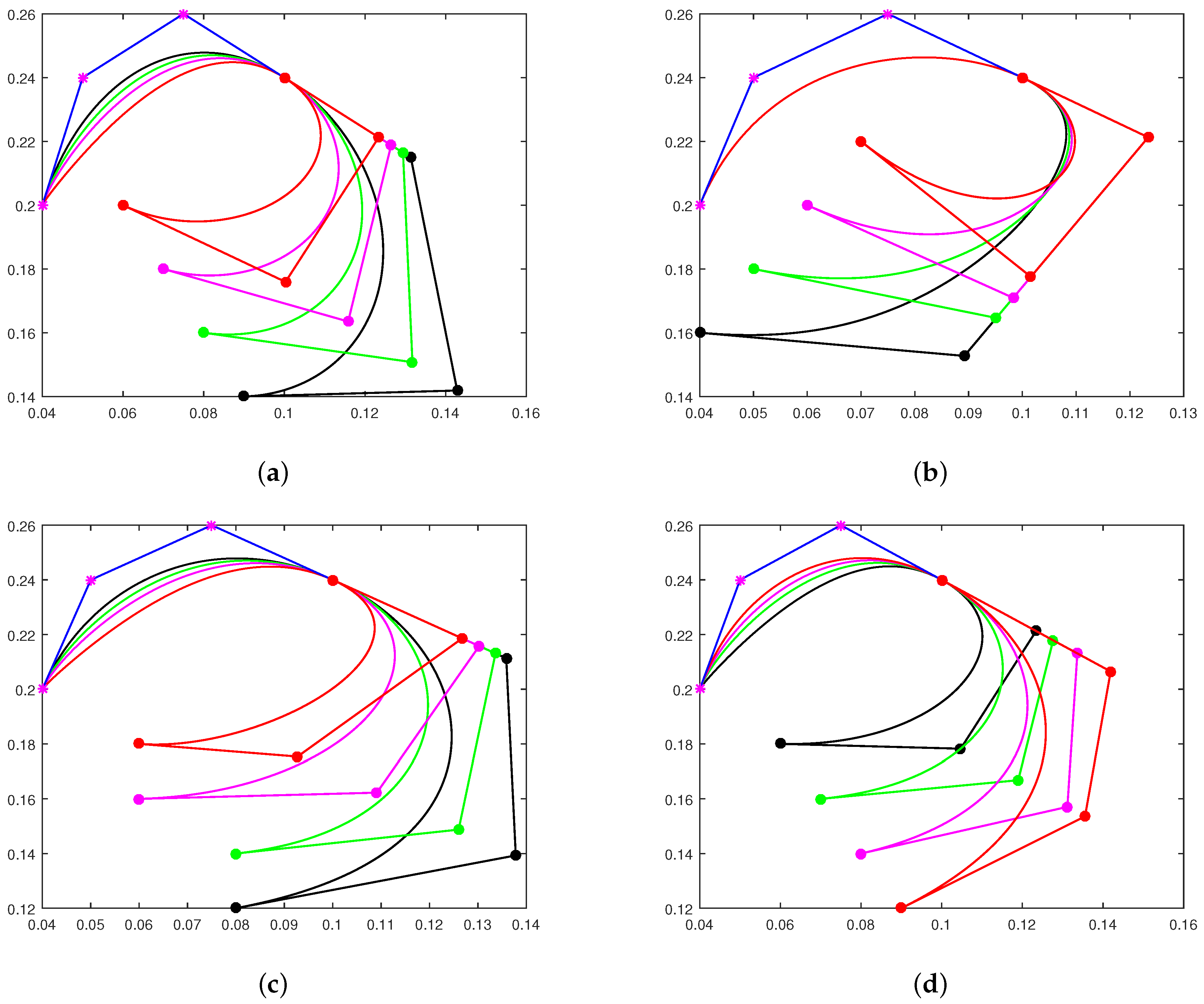
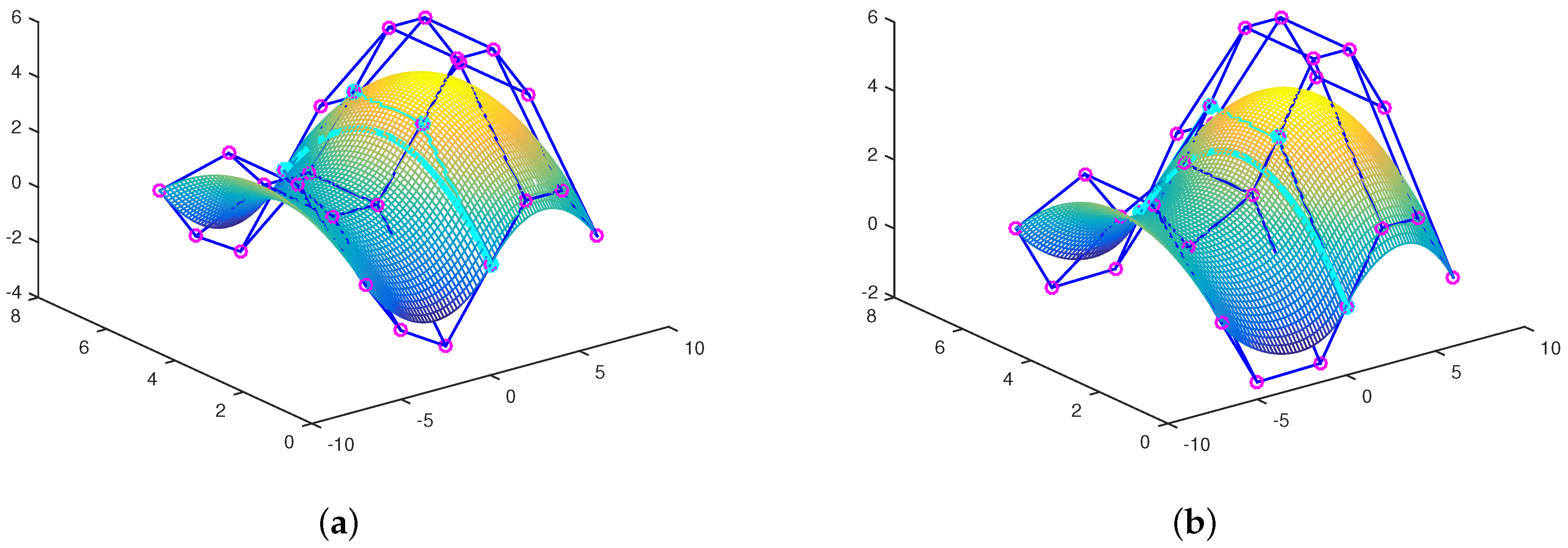

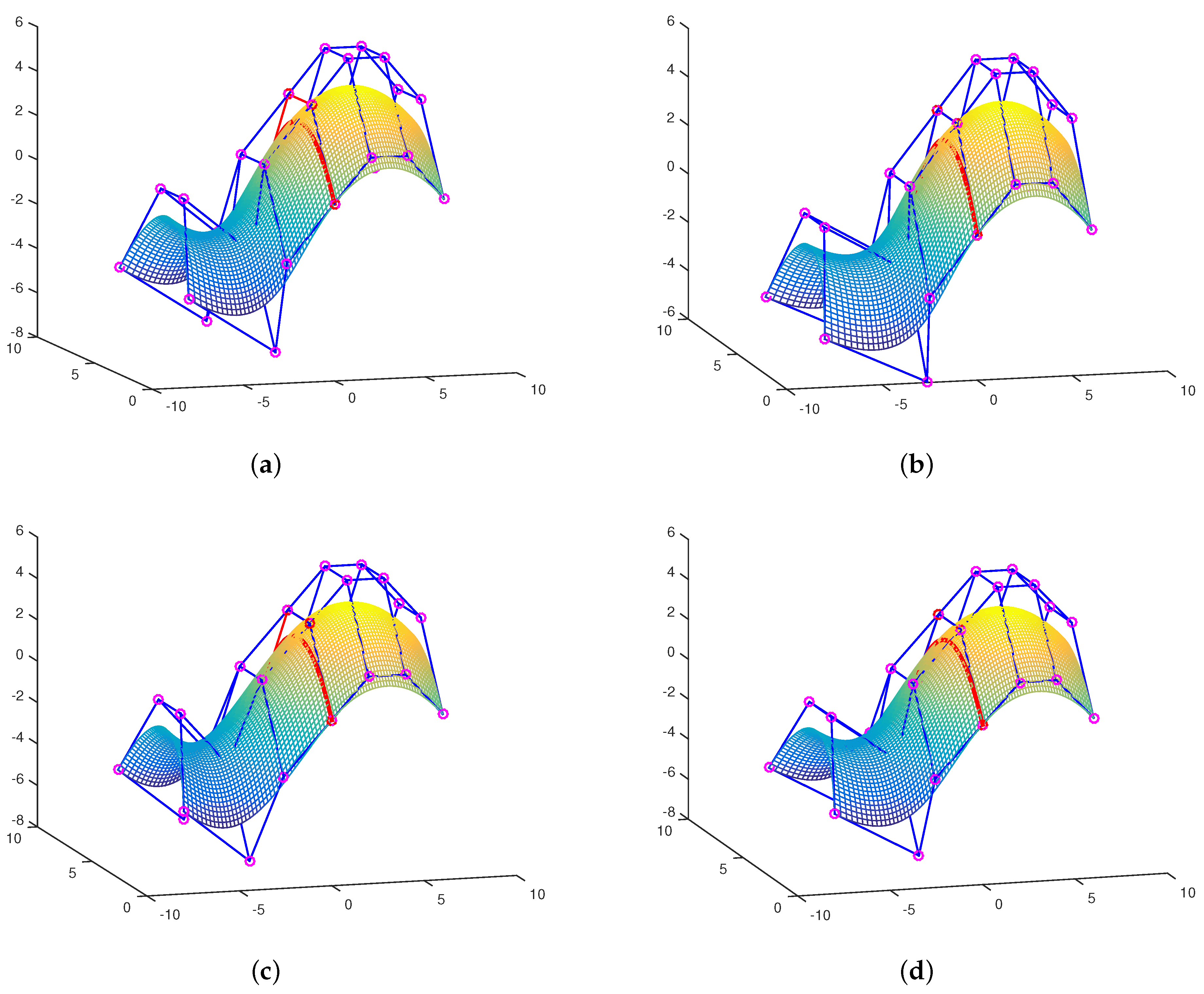
Publisher’s Note: MDPI stays neutral with regard to jurisdictional claims in published maps and institutional affiliations. |
© 2021 by the authors. Licensee MDPI, Basel, Switzerland. This article is an open access article distributed under the terms and conditions of the Creative Commons Attribution (CC BY) license (https://creativecommons.org/licenses/by/4.0/).
Share and Cite
Meng, W.; Li, C.; Liu, Q. Geometric Modeling of C-Bézier Curve and Surface with Shape Parameters. Mathematics 2021, 9, 2651. https://doi.org/10.3390/math9212651
Meng W, Li C, Liu Q. Geometric Modeling of C-Bézier Curve and Surface with Shape Parameters. Mathematics. 2021; 9(21):2651. https://doi.org/10.3390/math9212651
Chicago/Turabian StyleMeng, Wei, Caiyun Li, and Qianqian Liu. 2021. "Geometric Modeling of C-Bézier Curve and Surface with Shape Parameters" Mathematics 9, no. 21: 2651. https://doi.org/10.3390/math9212651
APA StyleMeng, W., Li, C., & Liu, Q. (2021). Geometric Modeling of C-Bézier Curve and Surface with Shape Parameters. Mathematics, 9(21), 2651. https://doi.org/10.3390/math9212651





